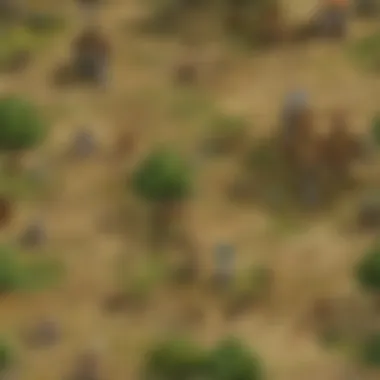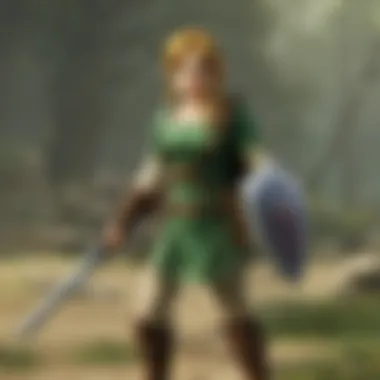Exploring Mini Games: A Deep Dive into Zelda's Charm


Intro
The Zelda franchise, with its rich lore and engaging narratives, often receives commendation for its main quests and character development. However, a crucial yet often-underestimated element is the incorporation of mini games. These mini games serve a dual purpose: they provide players with a break from the main storyline while also enriching the overall gaming experience. They allow players to engage with Hyrule in unique ways, expanding on the world’s depth.
This article delves into the intricacies of mini games across various titles in the Zelda universe. We will examine how these mini games have evolved, the mechanics behind them, and their importance to the game narrative and player engagement. By examining popular examples, we will uncover how these activities contribute to both player enjoyment and the broader context of the franchise.
Game Reviews
Gameplay Features and Mechanics
Mini games in the Zelda universe often feature engaging mechanics that challenge players’ skills and enhance the overall gameplay. Titles such as The Legend of Zelda: Ocarina of Time introduce activities like the Longshot Fishing, where precision and timing are required. In contrast, The Legend of Zelda: Breath of the Wild offers Shrines filled with various mini games that encompass puzzle-solving and combat challenges. These mechanics keep gameplay fresh and offer diverse experiences.
- Fishing: Requires skill and strategy to catch rarer types.
- Archery: Improves precision, often tied to main quests.
- Puzzle Solving: Engages critical thinking, rewarding exploration.
Storyline and Quests
Interestingly, these mini games often tie directly into the main storyline of their respective games. In The Legend of Zelda: Majora’s Mask, players can engage in the Bombers’ Notebook mini games. Completing these allows players to progress in side stories that enhance their understanding of the world and its characters. Thus, the mini games do not exist in isolation; they contribute to the broader narrative.
Visuals and Sound Design
Visual design and sound play pivotal roles in making mini games immersive. Take, for example, the vibrant colors and whimsical sounds of The Legend of Zelda: Wind Waker. The mini games, such as the sailing battles or the fishing game, utilize the game’s artistic style to create an enjoyable atmosphere. The integration of visuals and sound provides a richer experience, drawing players into the world even further.
Comparison with Previous Titles
Examining mini games also reveals a development of complexity across titles. In early games, mini games frequently served as simple diversions, often lacking intricate gameplay. However, newer entries like Breath of the Wild showcase how mini games have become more refined, with deeper mechanics and more substantial rewards for completion. This evolution reflects the developers’ understanding of players’ desires for greater engagement and meaningful interactions.
"Mini games in the Zelda franchise not only serve as engaging activities but also enrich storytelling, creating a labyrinth of narratives intertwined with player experiences."
Finale
This initial exploration into the significance of mini games in the Zelda universe reveals their vital role in enhancing player engagement and expanding the game world. As we continue the discussion, we will further examine character roles and the lore surrounding these often-overlooked features.
Understanding Mini Games
Mini games in the Zelda universe are not simply a collection of optional side activities. They serve essential purposes in enhancing the overall gaming experience. Firstly, they offer varied gameplay that complements the core objectives of each title. This variation is crucial for maintaining player interest and involvement. When players engage in mini games, they temporarily shift focus from the main narrative, exploring new mechanics while still being rewarded with items or lore pivotal to their journey.
Besides providing entertainment, mini games often encourage exploration and interaction within the richly crafted world of Hyrule. They incorporate unique challenges that reflect the themes and cultural nuances of the setting. Given their pervasive nature in the franchise, understanding mini games helps fans appreciate their significance beyond mere distractions.
Definition and Purpose
In the context of the Zelda games, mini games can be defined as smaller, self-contained activities or challenges found throughout the main game. They usually focus on specific skills or mechanics, offering players a break from the main storyline. The purpose of these mini games varies. Some are designed to reward players with collectibles, while others enhance skill levels or serve as stepping stones in the narrative.
Historical Context
The inclusion of mini games in Zelda titles has evolved over the years. Early entries featured simple tasks such as fishing or collecting rupees, emphasizing basic mechanics. As game design progressed, so did the complexity and thematic depth of these diversions. For instance, "The Legend of Zelda: Ocarina of Time" introduced more interactive elements and layered challenges, setting a precedent for future titles.
In summary, mini games have consistently played a vital role in enriching Zelda's gameplay. Their development reflects both the technological advancements in gaming and a deeper understanding of player engagement strategies.
The Role of Mini Games in Game Design
Mini games serve as a pivotal component in the Zelda franchise, deeply influencing game design. These activities are not mere distractions but integral parts of the gaming experience. They provide opportunities for the player to engage with the world of Hyrule on a different level. The addition of mini games often leads to richer narratives and enhances the overall enjoyment of the core gameplay. Each mini game reflects an aspect of the game world and contributes to the richness of the player's journey. They also introduce players to unique challenges that can enhance skill development, offering a break from traditional action or puzzle-solving mechanics.
Enhancing Player Engagement


Player engagement is crucial in any game, and mini games are designed with this in mind. The varied tasks they provide can capture the player’s attention and keep them invested in the game. For example, mini games in Ocarina of Time, like Fishing and Bombchu Bowling, offer players a chance to delve into activities that break the rhythm of the main quest. This change not only refreshes the gaming experience but also allows players to interact with beloved characters and locations in new ways.
Mini games often reward players with items or upgrades, increasing motivation to participate. This helps to create a cycle of engagement where players feel compelled to explore further, seeking out all possible mini games. The more players interact with these features, the more they feel connected to the game's world and its characters. When players are invested, they are likely to spend more time in the game, leading to deeper immersion within the lore of Hyrule.
Balancing Gameplay Mechanics
Balancing gameplay mechanics is a vital aspect of game design. Mini games in the Zelda series allow for a balance between different gameplay styles, ensuring that no single element dominates the experience. Players may find themselves frustrated by a challenging quest, but a mini game can offer a lighter, more enjoyable task as relief. This approach caters to diverse player preferences.
In titles like Breath of the Wild, various mini games serve to balance exploration, combat, and puzzle-solving by providing alternate activities. For instance, cooking challenges and Korok Seed challenges add layers of strategy without overwhelming the player with high-stakes action. This balance ensures that players remain engaged without feeling fatigued by constant pressure to succeed in the main quest.
Diversity and Accessibility
Diversity in mini games fosters a broader appeal. Each mini game offers unique mechanics and challenges, allowing various players to find something to enjoy. From the rhythmic challenges in The Wind Waker to the marksmanship tasks in Twilight Princess, the variety ensures that there’s something for everyone.
Accessibility is crucial. Mini games often feature simpler rules compared to the more complex main gameplay. This design choice allows new players or those unaccustomed to gaming to participate. It encourages those who may struggle with traditional gameplay to still engage and enjoy the experience. For veteran players, these simpler challenges can offer a refreshing break, ensuring that everyone has an opportunity to appreciate the lightheartedness often present in mini games.
Overall, mini games are not just side content. They enhance player engagement, balance gameplay mechanics, and ensure diversity and accessibility in the gaming experience. The Zelda franchise uses them as tools to deepen connections with the expansive world, enriching the player's journey through Hyrule.
Notable Mini Games in Different Titles
The exploration of mini games in the Zelda franchise reveals their diverse functions and forms, becoming a vital component of gameplay across titles. Not only do these activities offer a break from the main quest, but they also enhance the charm of Hyrule. Examining notable mini games from several installments highlights their influence on player experience and game design.
Mini Games in Ocarina of Time
Fishing
Fishing in Ocarina of Time introduces players to a serene landscape, allowing them to engage in a relaxing yet rewarding activity. This aspect highlights the game's depth by providing a contrasting pace to the adrenaline-fueled quests. Players find themselves immersed in the simple joy of waiting for a catch, which can be both calming and captivating.
One key characteristic of the fishing mini game is its accessibility. It can be enjoyed by players of all skill levels. The unique feature of catching different type of fish and earning items adds an extra layer of engagement. However, some may find that the simplicity of the mechanics lacks depth, potentially leading to a sense of repetitiveness over time.
Bombchu Bowling
Bombchu Bowling offers a more competitive edge to mini games found in Ocarina of Time. This involves players aiming to hit targets using Bombchus, providing a strategic element that different from other minigames.
Its key characteristic lies in the inclusion of physics and tactical placement of Bombchus, demanding precision and timing. Players often appreciate this challenge, making it a popular choice among fans. The unique feature of varying target distances and layouts requires adaptations in strategy. Despite its popularity, some players may find the controls a bit awkward which raises questions about overall enjoyment and accessibility.
The Wind Waker's Unique Offerings
Link’s Auction
Link’s Auction introduces players to the excitement of bidding, reinforcing social interaction within the game. This mini game not only allows players to acquire rare items but also creates a sense of competition among players in a virtual setting.
Its key characteristic is the dynamic nature of bidding which demands players to manage resources strategically. Players appreciate the thrill of outbidding others. The unique feature of auctioning in varying settings provides diversity within the gameplay. There can be potential frustrations, however, with the randomness of competitions, which could lead to imbalances in player experience.
Ghost Ship Targeting
Ghost Ship Targeting offers players an engaging challenge with precise shooting mechanics. The objective involves aiming at moving targets on the Ghost Ship, integrating combat skills with a mini game framework.
The key characteristic of this mini game is its emphasis on timing and accuracy. It has become a memorable part of Wind Waker's gameplay. The unique feature of different target types introduces further variation and enhances replayability. The downside is that it may prove frustrating for players who struggle with aiming mechanics, potentially detracting from their overall experience.
Twilight Princess and the Mini Game Evolution
Snowboarding


The snowboarding mini game in Twilight Princess stands out as a thrilling diversion. It combines speed with precision, allowing players to race down snowy slopes filled with obstacles. The key characteristic is the fast-paced nature, appealing to those who seek adrenaline.
It also features variations in terrain, keeping the experience fresh. However, some players may find it challenging to control the direction, which could lead to frustration.
Fishing Mini Games
Fishing in Twilight Princess builds upon the previous iterations, enhancing its mechanics for a richer experience. The mini game allows for improved control and more varied environments, making it more engaging. Its key characteristic is its expanded option for catching a wider range of fish.
The unique feature of mini games in this title includes collectibles that players can acquire, thus incentivizing participation. However, much like past entries, some players may feel a sense of monotony if overly focused on fishing.
Breath of the Wild: A New Era
Korok Seed Challenges
The Korok Seed Challenges introduce a new layer of exploration. Players uncover these seeds by completing various tasks throughout Hyrule. Its primary function promotes exploration and prodding curiosity about the world. The diversity of challenges varies in complexity, appealing to multiple play styles.
The key characteristic is the integration of puzzles, which captivates players looking for cerebral challenges. Yet, some may find the number of seeds excessive, leading to a sense of “busywork.”
Various Cooking Challenges
Cooking in Breath of the Wild serves as another captivating mini game. Players collect ingredients and experiment with recipes, fostering creative engagement. The potential combinations allow individual expression through cooking mechanics.
The unique aspects of cooking include discovering effects of ingredients, which adds strategy to exploration. However, the systems can be overwhelming for those less interested in culinary elements, leading to divided player opinions.
Cultural Significance of Mini Games
The cultural significance of mini games within the Zelda franchise goes beyond simple entertainment. These small segments enrich the gameplay experience while offering deeper insights into Hyrule's diverse lore and character interactions. Mini games serve not only as engaging distractions but also as reflections of the cultural contexts in which they are placed. This aspect can be seen as essential in understanding the broader narrative and social dynamics of the entire game series.
One of the primary benefits of mini games is their ability to immerse players in different aspects of Hyrule's world. Often, these games draw on traditional games or cultural practices, exhibiting elements such as strategy, skill, and even luck, which resonate culturally. Whether it's a fishing competition or an auction, these activities cement the player's sense of belonging in the game world and offer a glimpse into the customs of Hyrule.
Moreover, mini games provide diversity in gameplay styles that cater to wider audience preferences. Some players may favor completionist objectives, while others might simply enjoy the playful challenge of a mini game. This approach contributes to a more inclusive gaming environment, fostering engagement across various player demographics and preferences. Consequently, the cultural significance of these mini games is tied intimately to how they connect the player to Hyrule and to each other.
Mini Games as a Reflection of Hyrule's Culture
Within Hyrule, mini games often mimic the customs and traditions of the world, adding layers of authenticity to gameplay. Each mini game not only serves as an entertaining challenge but also reflects local values or history. For instance, the fishing mini game in Ocarina of Time mirrors the importance of fishing in many cultures as a source of sustenance and leisure.
The design of these games frequently showcases local aesthetics and folklore, enhancing a player’s understanding of the game’s setting. For example, The Wind Waker's auction house introduces players to the competitive nature of trade and commerce through a gameplay mechanic that encourages strategy and social interaction. The act of bidding and winning mirrors real-world auction dynamics, showcasing local economic practices and community engagement.
Thus, these mini games make Hyrule's culture more tangible, encouraging players to explore and understand the world on multiple levels. They serve as cultural artifacts that highlight social structures and relationships among the inhabitants of Hyrule.
Player Interaction and Community Engagement
Mini games in the Zelda universe cultivate player interaction, both within the game and in broader gaming communities. Through multiplayer functions or leaderboards in some titles, they encourage competition and collaboration among players. This interaction can foster social connections, promoting a sense of community among Zelda fans.
In addition, mini games offer a stage for communal activities where players can share tips, celebrate achievements, or even engage in live events. For example, many players share their high scores or unique strategies in fishing mini games on platforms like Reddit. This sharing of experiences not only aids in player progression but also solidifies a collective identity among fans.
Furthermore, some mini games have transcended the confines of single-player campaigns into fan-made competitions or online challenges. These activities enable players to participate in a shared culture that celebrates the creativity and competitiveness inspired by the franchise. Overall, mini games have become microcosms where interaction blooms, making the world of Zelda alive and exciting.
"Mini games form the connective tissue that binds the community together, fostering shared experiences that enhance the enjoyment of the overall Zelda journey."
Challenges and Critiques of Mini Games
Mini games within the Zelda universe play a vital role in the game's ecosystem. However, their presence is not without challenges and criticisms. This section aims to explore the complexities surrounding mini games, reflecting on their varying quality and the enduring issue of maintaining player engagement. Each of these aspects is crucial for understanding how mini games fit into the broader fabric of gameplay and player experience.


Inconsistent Quality Across Titles
One of the most prominent critiques of mini games in the Zelda series is the inconsistent quality found throughout various titles. While some mini games offer engaging mechanics and rewarding experiences, others may seem lackluster or overly simplistic. For instance, the fishing mini game in Ocarina of Time is often celebrated for its depth and enjoyment, while some less ambitious mini games in titles like The Wind Waker can feel detached or unrefined.
The disparities can arise due to various factors, including:
- Development resources: Some mini games may have received more attention and higher production values than others, leading to a noticeable difference in quality.
- Time constraints: When developers work under tight deadlines, compromises may occur, resulting in mini games that do not fully meet players' expectations.
- Player feedback: Responses to past mini games have led to changes or iterations, but sometimes feedback is misinterpreted or ignored, leading to further inconsistency.
This inconsistency can impact overall player satisfaction and may push players to overlook mini games entirely, feeling that they are a mere distraction rather than a significant enhancement to the gameplay experience.
Sustaining Player Interest
The challenge of sustaining player interest in mini games also warrants attention. As players delve into the Zelda universe, they may initially find excitement in mini games. However, the challenge lies in keeping that interest alive over time. For many, repetition can be a deterrent. Once a player has mastered the mechanics of a mini game, the novelty often fades, leading to disengagement.
Several strategies could enhance the longevity of interest, including:
- Diverse rewards: Mini games that offer varied rewards—like unique items or story progression—can encourage repeated play.
- Increasing complexity: As players progress, introducing more challenging variations of mini games can keep them engaged.
- Integration into the main storyline: When mini games carry significance within the broader narrative, players are more likely to engage with them as part of their journey through Hyrule.
Ultimately, without effort to sustain player interest, mini games may come off as side distractions rather than meaningful components of the overall experience.
In the fast-paced realm of modern gaming, mini games in Zelda must evolve to remain relevant and enjoyable for the dedicated fan base.
Through recognizing and addressing these critiques, the development teams behind future Zelda installments can enhance the quality and engagement of mini games, ensuring they augment the immersive experience rather than detract from it.
Future of Mini Games in the Franchise
The future of mini games in the Zelda franchise holds significant promise. As the gaming landscape evolves with new technologies and player expectations, it becomes critical to examine how mini games can adapt. The innovations in gameplay mechanics, graphics, and story integration will likely shape upcoming titles.
Potential Innovations
Several key areas merit exploration when discussing potential innovations for mini games.
- Advanced Interactivity: Future mini games could utilize more complex physics and interactivity. As technology advances, players may experience mini games where actions have realistic consequences.
- Online Multiplayer Features: Introducing competitive or cooperative modes can elevate mini games. Imagine players around the globe engaging in fishing or racing mini games, forming a community centered around these smaller challenges.
- Augmented Reality (AR) Integration: Using AR could transform how mini games are played. Players might interact with Hyrule in their own environment, bringing the world closer.
- Adaptive Difficulty Levels: Future designs could include systems that adjust difficulty based on player skill. This ensures that all players find engagement, which leads to a more inclusive gaming experience.
Integrating Mini Games into Larger Narratives
The integration of mini games into larger narratives is essential for enhancing the Zelda universe. This approach benefits both gameplay and storytelling.
- Story-Relevant Challenges: Mini games can serve as meaningful connections to the main narrative. They can enrich plot arcs, unlocking deeper character insights or lore about Hyrule.
- Character Development: Engaging in mini games allows players to learn about characters, not just through cutscenes but through their interactions in these gaming segments.
- World-Building Mechanisms: Mini games can showcase cultural aspects of Hyrule, creating a cohesive world for players to explore. Each challenge or diversion can add layers to the lore, painting a fuller picture of the game's environment.
"Mini games in Zelda are not merely distractions. They are powerful tools for storytelling and player engagement."
Ending
In the context of this article, the conclusion serves a pivotal role in synthesizing the myriad insights gained from the exploration of mini games in the Zelda franchise. It is here where one can appreciate the multifaceted nature of these engaging diversions, highlighting how they enhance player experience while contributing intricately to the overarching saga of Hyrule.
Summary of Insights
The examination of mini games reveals their essential function as more than mere distractions. They establish connections between players and the game's environment, offering moments of respite from primary quests while still enriching the narrative. Key elements in this discussion include:
- Variety and Innovation: Each title introduces unique mini games, showcasing fresh mechanics that cater to diverse player preferences.
- Cultural Significance: Mini games often reflect Hyrule's rich culture, reinforcing lore and enhancing immersion.
- Player Engagement: They provide opportunities for community interaction, both in-game and among players, fostering a sense of belonging.
These insights not only underscore the value of mini games but also illustrate their potential for future developments as the franchise continues to evolve.
Final Thoughts on the Impact of Mini Games
Reflecting on the impact of mini games within the Zelda universe, it becomes clear that these elements are integral to the franchise's identity. They offer players an avenue for exploration and creativity, further embedding them into Hyrule's lore. Considerations for the future might include:
- Technological Advances: With gaming technology continually evolving, mini games could leverage new mechanics, offering deeper interactive experiences.
- Narrative Integration: Future titles may blend mini games more seamlessly into the main story, enhancing the overall coherence of the game's narrative structure.
- Community-Centered Design: A potential focus on cooperative or multiplayer mini games could enhance player bonding and engagement.
In essence, the impact of these small yet significant components cannot be overstated. They not only elevate gameplay but also ensure that the player's journey through Hyrule is an enriching and memorable experience.







